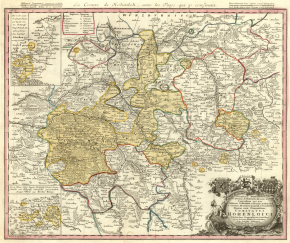Hohenlohe
Coordinates: 49 ° 15 ' N , 9 ° 36' E
Hohenlohe is geographically a region in the north-east of Baden-Württemberg , but can - depending on the definition - extend into Bavarian Middle and Lower Franconia .
Belonging to the East Franconian dialect area , Hohenlohe is part of Franconia .
location
Hohenlohe is now understood to mean the Franconian-speaking area around the Jagst , Kocher and Tauber rivers , which is almost congruent with the Hohenlohe district, the Schwäbisch Hall district to the east and the southern part of the Main-Tauber district (the former Mergentheim district ). Former possessions of the House of Hohenlohe in today's neighboring Bavaria such as Schillingsfürst , Baldersheim and Uffenheim are also sometimes included.
history
Hohenlohe was originally a dynastic term and name of the county or later of the principality of the House of Hohenlohe , which still exists today and which encompassed a large part of today's landscape. Between 1500 and 1806 Hohenlohe belonged to the Franconian Empire . After most of their dominion was forcibly incorporated into the Kingdom of Württemberg in 1806 , Hohenlohe continued to exist as a geographical term, for example in the naming of the Hohenlohe plain . The adjective "Hohenlohe" denotes the local dialect and especially the affiliation with the Hohenlohe family, while "Hohenloher" is used for the landscape and its inhabitants: Hohenlohe-speaking Hohenlohe people live in the Hohenlohe plain, some of them in the former Hohenlohe cities, their old ones Official houses bear Hohenlohe coats of arms.
Geology and geomorphology
Main article: Hohenlohe level
Attractions
Hohenlohe is a "land of castles and palaces". Worth mentioning are e.g. As the castle Krautheim , the castle Leofels and ruin Forchtenberg and the castles Bartenstein , Kirchberg , Langenburg , Neuenstein , Öhringen , Pfedelbach , Schillingsfürst , Waldenburg and Weikersheim , some of which can be visited.
The town of Waldenburg, on the edge of the Swabian-Franconian Forest , and the Pfedelbach district of Heuberg offer views over large parts of the Hohenlohe plain.
economy
Many important companies have their headquarters in the Hohenlohe district; Measured by the number of inhabitants, most of the world market leaders are represented here in Germany. The Würth Group with around 73,000 employees worldwide (as of July 2017), one of the largest Hohenloh companies, is based in Künzelsau -Gaisbach. The Gerhard Sprügel GmbH , based in Ingelfingen-Stachenhausen acts since 1974 with fastening technology. Albert Berner Deutschland is based in Künzelsau-Garnberg , the valve specialists Bürkert and GEMÜ have their headquarters in Ingelfingen and Criesbach , and the explosion protection specialist R. Stahl is based in Waldenburg. Heavy-duty transporters are manufactured at Scheuerle Fahrzeugfabrik GmbH in Pfedelbach . Other important companies are the fan manufacturers ebm-papst in Mulfingen and Ziehl-Abegg in Künzelsau. In addition, with the Mustang Jeans, the “German” jeans were created in Hohenlohe. Gammesfeld is known for the Klein- Raiffeisenbank there .
In the east of Hohenlohe, especially in and around Crailsheim and Schwäbisch Hall , a number of medium-sized special machine manufacturers have settled, which mainly deal with packaging technology. The abundance of relevant companies in the packaging industry and the fact that some of them are market leaders led to the foundation of the Packaging Valley Germany eV association in 2007 in the Schwäbisch Hall district . This part of Hohenlohe is home to the Schwäbisch Hall building society , the largest member of the private building society association.
On the heights of the fertile and poorly forested Hohenlohe Plain, agriculture still plays a key role. In the municipality of Blaufelden alone, which has around 5,000 inhabitants, there are still almost one hundred full-time farms and in the Hohenlohe district of around 777 km², almost 60% of the area is used for agriculture. The domestic pig breed Schwäbisch-Hällisches Landschwein, which has become known nationwide, also has its home in Hohenlohe.
In addition, Hohenloher wine is grown in some areas . For example, on the slopes of the Jagsttal in Krautheim- Klepsau, Dörzbach and Schöntal , on those of the Kocher in Ingelfingen , Niedernhall and Forchtenberg , on those of the Taubertal in Weikersheim and Bad Mergentheim - Markelsheim and on the Keuperstufe to the Swabian-Franconian Forest in the districts of Neuenstein , in Pfedelbach , Öhringen and Bretzfeld .
See also: Württemberg (wine-growing region) and Württemberg Wine Route .
dialect
Main article : Hohenlohisch
The Hohenlohe dialect, the Hohenlohe dialect, is common to the entire region. It is an East Franconian dialect , which, in addition to the neighboring East Franconian dialects such as Ansbach or Taubergründisch, also has similarities to the dialect groups South Franconian and Swabian .
literature
- Siegfried Baier: The Hohenloher Land . Baier Verlag, Crailsheim 2001, ISBN 3-929233-13-4 .
- Friedrich Karl Prince of Hohenlohe-Waldenburg: On the forest history of the Hohenlohe country . Reports Freiburg Forest Research, Issue 65. Forestry Experimental and Research Institute Baden-Württemberg, Freiburg im Breisgau 2006.
- Frank Kleinehagenbrock: The County of Hohenlohe in the Thirty Years War. An empirical study of rulers and subjects. Kohlhammer, Stuttgart 2003, ISBN 3-17-018102-5 .
- Rudolf hose: Hohenlohe Franconia. Glock and Lutz, Nuremberg 1964.
- Richard Schmidt: Hohenloher Land ( German Land - German Art ). 3rd edition, Munich / Berlin 1971.
- Gertrud Schubert, Roland Schweizer: Hohenlohe - landscape, people and culture . Mira-Verlagsgesellschaft, Künzelsau 2002, ISBN 3-89222-620-2 .
Web links
Individual evidence
- ^ Karl Schumm: Hohenlohe. Castles and palaces . In: Heilbronn Historical Association. 20. Publication. Heilbronn 1951. pp. 200-215
- ^ Article in the Süddeutsche Zeitung of May 14, 2009
- ↑ Adolf Würth GmbH & Co. KG: Current key figures of the Würth Group | Würth Group. Retrieved October 14, 2017 .
-
↑ Page no longer available , search in web archives: Article of the Baden-Württemberg Society for International Economic and Scientific Cooperation from July 2009 Packaging Valley Germany eV - Objective and self-presentation , accessed on September 18, 2012
